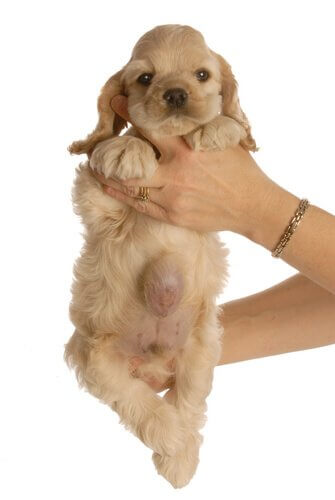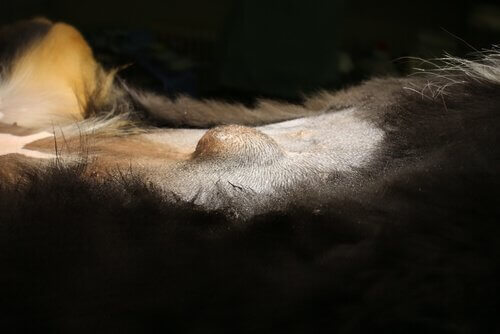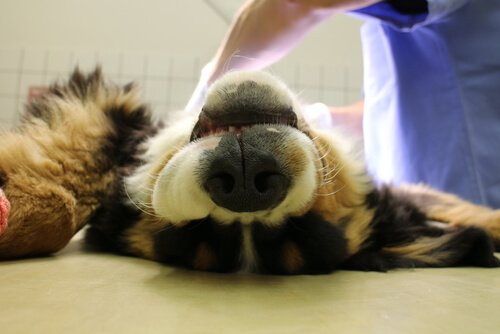Umbilical Hernia in Newborn Puppies

When an umbilical hernia appears, a newborn puppy may not seem sick. Generally, they seem perfectly healthy. In fact, most of the hernias, especially those that are small, don’t pose any danger and a vet will often find them during vet checkups.
However, it’s important to detect and treat hernias, because in some cases they could be a serious threat to your pet’s health. Next, we’ll look at some clues to identify the symptoms of an umbilical hernia in a puppy and seek the appropriate treatment.
What’s an umbilical hernia?
When a dog or cat has a small lump in the lower part of its belly, between the ribs and the hind legs, it’s most likely an umbilical hernia. In other words, a protuberance that’s left in the place where the umbilical cord used to be attached.
The presence of that lump is the sign that the umbilical wound didn’t close properly, so the intestines and belly fat come out through it. However, this is not an open wound, but it’s covered by the dog’s own skin.
How does a hernia form? At the moment of birth, the mother cuts the umbilical cord with her teeth. The navel is originally a hole, although, it usually closes in a few days.

Attached to the navel of a newborn there’s a piece of cord that, in general, also falls shortly after. But, when the navel hole doesn’t heal properly, an umbilical hernia ensues.
Symptoms of an umbilical hernia in puppies
The clearest symptom that a puppy has an umbilical hernia is the presence of a small lump in its belly. Under normal conditions, this lump should be pink, and smooth. If this isn’t the case and, on the contrary, there’s a harder protrusion in the place where the cord used to be, then it’s a hernia.
When feeling the small lump, it’s possible that the puppy may feel a little pain. Furthermore, the greater the hernia, the greater the pain. Usually, the lump gets bigger as time goes by.
If it’s a newborn animal then it’s possible that the protrusion will disappear by itself, or at least won’t grow anymore. However, it’s important to observe the evolution of the scar and, if it becomes larger, go ahead and consult your vet in order to avoid possible complications.
Reasons to be alarmed
The majority of umbilical hernias in puppies aren’t emergencies, and some even disappear spontaneously. However, if not, then, it’s important to correct them because in some cases the hernia can be strangulated.

A strangulated hernia is, indeed, an emergency since it could lead to the death of a puppy in just 48 hours. Moreover, be attentive to certain signs that indicate its presence.
A hernia is dangerous when the blood flow to the tissue cuts out or becomes scarce. (This is a strangulated hernia.) The main symptoms of it are excessive swelling of the hernia, fever, decay, severe pain, lack of appetite, and vomiting.
Then, the dead tissue becomes toxic and the whole organism is infected in a very short time. So, if you notice any of the symptoms mentioned above, take your puppy to the vet immediately.
Treatment of umbilical hernia in puppies
Each case is different and evaluation by a professional is the only way to determine the proper procedure. The treatment of an umbilical hernia in puppies varies according to its severity and the age of the animal.
If the hernia is small and doesn’t present any complications, the doctor will probably recommend waiting until the puppy’s six month birthday to see if it closes by itself. If it doesn’t, then they’ll need a new evaluation.
In the case of bigger or persistent hernias, it’s necessary to perform a surgical intervention. This procedure involves pushing the tissue that protrudes through the hole and putting stitches in the wound. It’s a very simple intervention, and you could take advantage and neuter the puppy right then.
All cited sources were thoroughly reviewed by our team to ensure their quality, reliability, currency, and validity. The bibliography of this article was considered reliable and of academic or scientific accuracy.
- Robinson, R. (1977). Genetic aspects of umbilical hernia incidence in cats and dogs. The Veterinary Record, 100(1), 9-10.
- Alkattan, L. M., Al-Qidi, A. S., & Alajeily, R. R. (2018). Hernioplasty in a huskydog puppy: case report. Al-Anbar Journal of Veterinary Sciences, 11(2).
- Kumar, N., Saxena, A. C., Dewangan, R., Kumar, A., Sharma, A. K., & Maiti, S. K. (2009). Umbilical Hernia (Double Hernial Ring) in a German Shepherd Dog. INTAS POLIVET, 10(2), 364-366.
